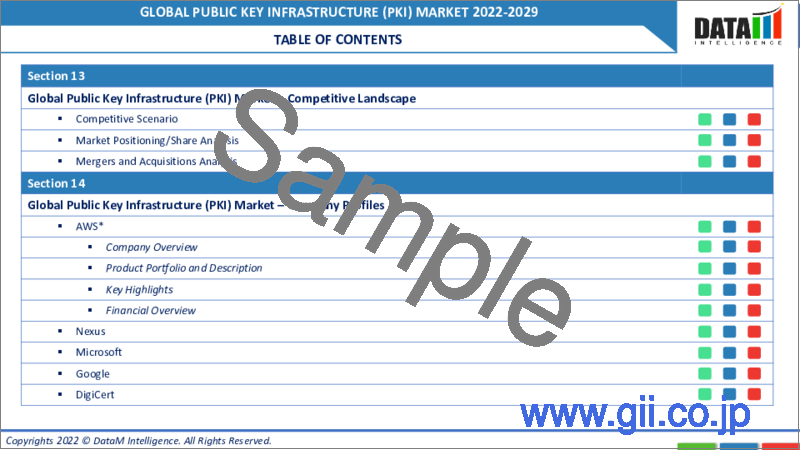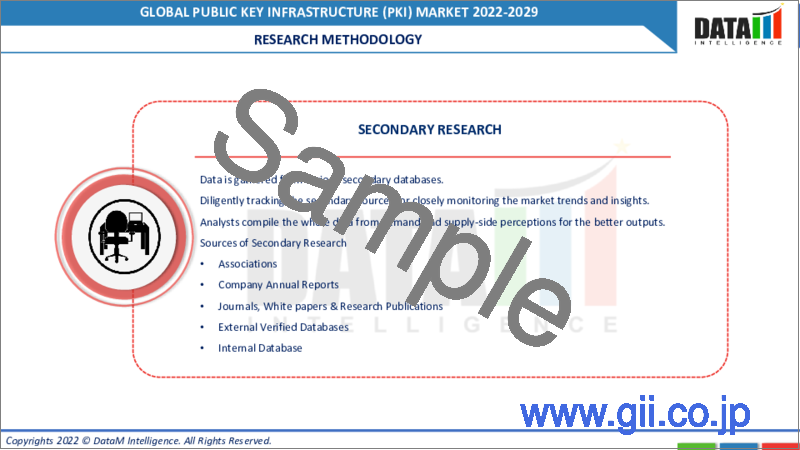|
|
市場調査レポート
商品コード
1082761
公開鍵基盤(PKI)の世界市場(2022年~2029年)Global Public Key Infrastructure (PKI) Market - 2022-2029 |
||||||
|
● お客様のご希望に応じて、既存データの加工や未掲載情報(例:国別セグメント)の追加などの対応が可能です。 詳細はお問い合わせください。 |
|||||||
| 公開鍵基盤(PKI)の世界市場(2022年~2029年) |
|
出版日: 2022年06月03日
発行: DataM Intelligence
ページ情報: 英文 195 Pages
納期: 約2営業日
|
- 全表示
- 概要
- 目次
当レポートでは、世界の公開鍵基盤(PKI)について調査分析し、市場の概要とともに、市場動向、市場促進・抑制要因、COVID-19の影響、業界分析、セグメント別・地域別の市場分析、競合情勢、企業プロファイルなどの情報を提供しています。
目次
第1章 世界の公開鍵基盤(PKI)市場:範囲と調査手法
- 調査手法
- 調査の目的と調査範囲
第2章 世界の公開鍵基盤(PKI)市場:市場の定義と概要
第3章 世界の公開鍵基盤(PKI)市場:エグゼクティブサマリー
- コンポーネント別の市場内訳
- サービス別の市場内訳
- 展開モード別の市場内訳
- 組織規模別の市場内訳
- エンドユーザー別市場内訳
- 地域別の市場内訳
第4章 世界の公開鍵基盤(PKI)市場力学
- 市場に影響を与える要因
- 促進要因
- 抑制要因
- 市場機会
- 影響分析
第5章 世界の公開鍵基盤(PKI)市場:業界分析
- ポーターのファイブフォース分析
- サプライチェーン分析
- 価格分析
- 規制分析
第6章 世界の公開鍵基盤(PKI)市場:COVID-19分析
- 市場へのCOVID-19の影響分析
- COVID-19前の市場シナリオ
- 現在のCOVID-19の市場シナリオ
- COVID-19後または将来のシナリオ
- COVID-19における価格変動
- 需要と供給のスペクトル
- パンデミック時の市場に関連する政府の取り組み
- メーカーの戦略的取り組み
- 結論
第7章 世界の公開鍵基盤(PKI)市場:コンポーネント別
- イントロダクション
- 市場規模分析・前年比成長分析(%):コンポーネント別
- 市場魅力指数:コンポーネント別
- ハードウェアセキュリティモジュール(HSM)
- イントロダクション
- 市場規模分析・前年比成長分析(%)
- ソリューション
- サービス
第8章 世界の公開鍵基盤(PKI)市場:サービス別
- イントロダクション
- 市場規模分析・前年比成長分析(%):サービス別
- 市場魅力指数:サービス別
- 専門
- イントロダクション
- 市場規模分析および前年比成長分析(%)
- 管理
第9章 世界の公開鍵基盤(PKI)市場:展開モード別
- イントロダクション
- 市場規模分析・前年比成長分析(%):展開モード別
- 市場魅力指数:展開モード別
- クラウド
- イントロダクション
- 市場規模分析・前年比成長分析(%)
- オンプレミス
第10章 世界の公開鍵基盤(PKI)市場:組織規模別
- イントロダクション
- 市場規模分析・前年比成長分析(%):組織規模別
- 市場魅力指数:組織規模別
- 中小企業
- イントロダクション
- 市場規模分析・前年比成長分析(%)
- 大企業
第11章 世界の公開鍵基盤(PKI)市場:エンドユーザー別
- イントロダクション
- 市場規模分析・前年比成長分析(%):エンドユーザー別
- 市場魅力指数:エンドユーザー別
- BFSI
- イントロダクション
- 市場規模分析・前年比成長分析(%)
- 政府と防衛
- ITと通信
- 小売
- ヘルスケア
- 製造
- その他
第12章 世界の公開鍵基盤(PKI)市場:地域別
- イントロダクション
- 市場規模分析・前年比成長分析(%):地域別
- 市場魅力指数:地域別
- 北米
- イントロダクション
- 主要な地域固有のダイナミクス
- 市場規模分析・前年比成長分析(%):コンポーネント別
- 市場規模分析・前年比成長分析(%):サービス別
- 市場規模分析・前年比成長分析(%):展開モード別
- 市場規模分析・前年比成長分析(%):組織規模別
- 市場規模分析・前年比成長分析(%):エンドユーザー別
- 市場規模分析・前年比成長分析(%):国別
- 欧州
- イントロダクション
- 主要な地域固有のダイナミクス
- 市場規模分析・前年比成長分析(%):コンポーネント別
- 市場規模分析・前年比成長分析(%):サービス別
- 市場規模分析・前年比成長分析(%):展開モード別
- 市場規模分析・前年比成長分析(%):組織規模別
- 市場規模分析・前年比成長分析(%):エンドユーザー別
- 市場規模分析・前年比成長分析(%):国別
- 南米
- イントロダクション
- 主要な地域固有のダイナミクス
- 市場規模分析・前年比成長分析(%):コンポーネント別
- 市場規模分析・前年比成長分析(%):サービス別
- 市場規模分析・前年比成長分析(%):展開モード別
- 市場規模分析・前年比成長分析(%):組織規模別
- 市場規模分析・前年比成長分析(%):エンドユーザー別
- 市場規模分析・前年比成長分析(%):国別
- アジア太平洋
- イントロダクション
- 主要な地域固有のダイナミクス
- 市場規模分析・前年比成長分析(%):コンポーネント別
- 市場規模分析・前年比成長分析(%):サービス別
- 市場規模分析・前年比成長分析(%):展開モード別
- 市場規模分析・前年比成長分析(%):組織規模別
- 市場規模分析・前年比成長分析(%):エンドユーザー別
- 市場規模分析・前年比成長分析(%):国別
- 中東とアフリカ
- イントロダクション
- 主要な地域固有のダイナミクス
- 市場規模分析・前年比成長分析(%):コンポーネント別
- 市場規模分析・前年比成長分析(%):サービス別
- 市場規模分析・前年比成長分析(%):展開モード別
- 市場規模分析・前年比成長分析(%):組織規模別
- 市場規模分析・前年比成長分析(%):エンドユーザー別
第13章 世界の公開鍵基盤(PKI)市場:競合情勢
- 競合シナリオ
- 市場ポジショニング/シェア分析
- 合併と買収の分析
第14章 世界の公開鍵基盤(PKI)市場:企業プロファイル
- AWS
- 企業概要
- 製品ポートフォリオ・説明
- 主要ハイライト
- 財務概要
- Nexus
- Microsoft
- DigiCert
- Cygnacom Solutions
- SecureMetric
- Futurex
- GlobalSign
- WISeKey
第15章 世界の公開鍵基盤(PKI)市場:重要考察
第16章 世界の公開鍵基盤(PKI)市場:DataM
Market Overview
The global public key infrastructure (PKI) market reached US$ XX million in 2021 and is expected to reach US$ XX million by 2029, growing at a CAGR of XX% during the forecast period 2022-2029.
The term "public key infrastructure" (PKI) refers to the tools used to generate and manage public keys for encryption, a prevalent technique for safeguarding data transfers over the internet. PKI is incorporated into all modern web browsers and aids in the security of public internet traffic. Organizations can use it to safeguard internal communications and ensure that linked devices can connect securely. The cryptographic keys are part of the encryption process and authenticate different persons or devices seeking to communicate with the network.
PKI is critical because of the encryption and authentication it controls and ensures reliable, secure internet communication. For an organization, PKI can mean the difference between an attacker getting access to the network via a connected device and keeping a potentially dangerous threat at bay. PKI operates by utilizing two technologies: certificates and keys. A key is a lengthy number that is used to encrypt data. The public key is open access and is used to encrypt messages. After receiving the communication, a private key is employed to decrypt it. A sophisticated mathematical equation is used to connect the keys.
Market Dynamics
Increasing adoption of advanced technologies in business places. Nevertheless, A lack of expertise and resources hampers the PKI market's evolution.
Increasing adoption of advanced technologies in business places
Global organizations are paying increasing attention to the impact of new applications on PKI, such as IoT. The Internet of Things has benefited almost every industrial sector. Businesses are more concerned with releasing new products on schedule than correctly executing security measures. It elevates cyber dangers to IoT device security in general. There are more breaches than ever before, and attackers use sophisticated techniques to carry them out. Because IoT devices are network-connected, they are frequently utilized in Distributed Denial of Service attacks and provide additional vulnerabilities due to weak password-only limitations. PKI has shown to be a very secure and versatile solution for protecting and controlling the connected devices' life cycle. Therefore, the growing adoption of advanced network technologies boosts the global public key infrastructure (PKI) market and acts as a major market driver.
Lack of expertise and resources
PKI necessitates specialist expertise in both deployment and operation. Due to the complexities of PKI, individuals with extensive knowledge and expertise are required to install and execute PKI correctly. The number of specialists specializing in PKI is dwindling. It is not always regarded as a critical business process.
COVID-19 Impact Analysis
Cloud computing has emerged as a crucial ally for remote work and collaboration development businesses. Businesses are increasingly storing sensitive information in the cloud. However, the growing use of the cloud presents security risks. With the growing need for cloud computing, there is a potential for cloud security services and solutions to emerge.
The increased usage of cell phones and global internet penetration causes people to use PKI. These shifting patterns and scattered IT architectures have made firms more vulnerable to cyber-attacks and data breaches, increasing the demand for PKI solutions. The danger of data breaches in security and access patterns and processes required to regulate cloud environments while working from home has increased with the advent of new gadgets. The demand for security technologies has increased significantly as remote workers have increased. Different governments and regulatory bodies have ordered public and private organizations to adopt new teleworking and social distance practices. As a result, the public key infrastructure (PKI) market will rise dramatically even after the pandemic.
Segment Analysis
The global public key infrastructure (PKI) market is classified based on components, services, deployment mode, organization size, end-user, and region.
Large-scale digitalization of the BFSI sector as an aftereffect of the COVID-19 pandemic
During the COVID-19 outbreak, banks and financial organizations migrated more of their data and services to an online environment. With the fast-paced adoption of cloud computing and integration of AI, finance and insurance firms must adhere to the highest security standards mandated by financial regulatory agencies. As a result, financial institutions are expanding their collaborations with public key infrastructure (PKI) service providers to establish a comprehensive security environment that meets global and regional regulatory requirements, enabling the BFSI sector to expand extensively and dominate the vertical segment of the global public key infrastructure (PKI) market.
Geographical Analysis
High technological advancements and their large-scale implementation achieved by North America
North America dominates the regional segment of PKImarket due to the early adoption of PKI and the availability of multiple suppliers offering PKI solutions. Businesses in this region are progressively employing PKI solutions to enable data security, prevent cyber-attacks and commercial espionage, and provide data security and privacy for business continuity.
Competitive Landscape
In terms of the number and scope of global and local producers, the public key infrastructure (PKI) market is quite active. The industry has been described as fragmented due to multiple manufacturers such as AWS, Nexus, Microsoft, Google, DigiCert, Cygnacom Solutions, SecureMetric, Futurex, GlobalSign, and WISeKey. Mergers, acquisitions, product launches, investments, and partnerships are common market strategies employed by major market players to obtain a competitive advantage and boost their reputation.
DigiCert
Overview: DigiCert provides TLS/SSL, IoT, and PKI identity and encryption solutions. DigiCert is chosen by the most creative firms, including 89 percent of the Fortune 500 and 97 percent of the top 100 worldwide banks, for its expertise in identity and encryption for web servers and Internet of Things devices. DigiCert's certificate lifecycle management system, CertCentral, provides TLS and other digital certificates for PKI implementations of any size. DigiCert was established in 2003 and is known for its enterprise-grade certificate management platform, responsive and knowledgable customer service, and market-leading security solutions. The firm employs around 5000 employees.
Product Portfolio:
DigiCert ONE: DigiCert ONE reimagines PKI with cloud-native design and container-based technology as the PKI infrastructure solution for today's security concerns. DigiCert ONE provides various administration options intended for all PKI use cases. Because of its adaptability may be implemented on-premises, in-country, or in the cloud to meet strict criteria, custom integrations, and airgap requirements. Thanks to a solid and highly scalable infrastructure, it also promptly deploys extraordinarily large numbers of certificates. DigiCert ONE provides centralized user and device certificate management from start to finish, ensuring trust across dynamic IT architectures.
Key Development:
On May 12, 2021, DigiCert announced that it had been chosen by the Telecom Infra Project (TIP) to provide global PKI-based security services for the company's OpenWiFi. The DigiCert IoT Device Manager will provide highly scalable, completely automated digital certificate administration to help OpenWiFi achieve next-generation Wi-Fi accessibility.
Why Purchase the Report?
- To visualize the global public key infrastructure (PKI) market segmentation based on component, services, deployment mode, organization size, end-user, and region, as well as understand key commercial assets and players.
- Identify commercial opportunities in the global public key infrastructure (PKI) market by analyzing trends and co-development.
- Excel data sheet with numerous data points of public key infrastructure (PKI) market-level with four segments.
- PDF report consisting of cogently put together market analysis after exhaustive qualitative interviews and in-depth market study.
- Product mapping available as excel consisting of key products of all the major market players
The global public key infrastructure (PKI) market report would provide approximately 77 tables, 77 figures and almost 195 pages.
Target Audience 2023
- Manufacturers/ Buyers
- Industry Investors/Investment Bankers
- Research Professionals
- Emerging Companies
Table of Contents
1. Global Public Key Infrastructure (PKI) Market - Methodology and Scope
- 1.1. Research Methodology
- 1.2. Research Objective and Scope of the Report
2. Global Public Key Infrastructure (PKI) Market - Market Definition and Overview
3. Global Public Key Infrastructure (PKI) Market - Executive Summary
- 3.1. Market Snippet by Component
- 3.2. Market Snippet by Services
- 3.3. Market Snippet by Deployment Mode
- 3.4. Market Snippet by Organization Size
- 3.5. Market Snippet by End-User
- 3.6. Market Snippet by Region
4. Global Public Key Infrastructure (PKI) Market-Market Dynamics
- 4.1. Market Impacting Factors
- 4.1.1. Drivers
- 4.1.1.1. XX
- 4.1.1.2. XX
- 4.1.2. Restraints
- 4.1.2.1. High cost
- 4.1.2.2. XX
- 4.1.3. Opportunity
- 4.1.3.1. XX
- 4.1.4. Impact Analysis
- 4.1.1. Drivers
5. Global Public Key Infrastructure (PKI) Market - Industry Analysis
- 5.1. Porter's Five Forces Analysis
- 5.2. Supply Chain Analysis
- 5.3. Pricing Analysis
- 5.4. Regulatory Analysis
6. Global Public Key Infrastructure (PKI) Market - COVID-19 Analysis
- 6.1. Analysis of COVID-19 on the Market
- 6.1.1. Before COVID-19 Market Scenario
- 6.1.2. Present COVID-19 Market Scenario
- 6.1.3. After COVID-19 or Future Scenario
- 6.2. Pricing Dynamics Amid COVID-19
- 6.3. Demand-Supply Spectrum
- 6.4. Government Initiatives Related to the Market During Pandemic
- 6.5. Manufacturers Strategic Initiatives
- 6.6. Conclusion
7. Global Public Key Infrastructure (PKI) Market - By Component
- 7.1. Introduction
- 7.1.1. Market Size Analysis and Y-o-Y Growth Analysis (%), By Component
- 7.1.2. Market Attractiveness Index, By Component
- 7.2. Hardware Security Modules (HSM)*
- 7.2.1. Introduction
- 7.2.2. Market Size Analysis and Y-o-Y Growth Analysis (%)
- 7.3. Solutions
- 7.4. Services
8. Global Public Key Infrastructure (PKI) Market - By Services
- 8.1. Introduction
- 8.1.1. Market Size Analysis and Y-o-Y Growth Analysis (%), By Services
- 8.1.2. Market Attractiveness Index, By Services
- 8.2. Professional*
- 8.2.1. Introduction
- 8.2.2. Market Size Analysis and Y-o-Y Growth Analysis (%)
- 8.3. Managed
9. Global Public Key Infrastructure (PKI) Market - By Deployment Mode
- 9.1. Introduction
- 9.1.1. Market Size Analysis and Y-o-Y Growth Analysis (%), By Deployment Mode
- 9.1.2. Market Attractiveness Index, By Deployment Mode
- 9.2. Cloud*
- 9.2.1. Introduction
- 9.2.2. Market Size Analysis and Y-o-Y Growth Analysis (%)
- 9.3. On-Premises
10. Global Public Key Infrastructure (PKI) Market - By Organization Size
- 10.1. Introduction
- 10.1.1. Market Size Analysis and Y-o-Y Growth Analysis (%), By Organization Size
- 10.1.2. Market Attractiveness Index, By Organization Size
- 10.2. Small and Medium-Sized Enterprises*
- 10.2.1. Introduction
- 10.2.2. Market Size Analysis and Y-o-Y Growth Analysis (%)
- 10.3. Large enterprises
11. Global Public Key Infrastructure (PKI) Market - By End-User
- 11.1. Introduction
- 11.1.1. Market Size Analysis and Y-o-Y Growth Analysis (%), By End-User
- 11.1.2. Market Attractiveness Index, By End-User
- 11.2. BFSI*
- 11.2.1. Introduction
- 11.2.2. Market Size Analysis and Y-o-Y Growth Analysis (%)
- 11.3. Government and Defense
- 11.4. IT and Telecom
- 11.5. Retail
- 11.6. Healthcare
- 11.7. Manufacturing
- 11.8. Others
12. Global Public Key Infrastructure (PKI) Market - By Region
- 12.1. Introduction
- 12.1.1. Market Size Analysis and Y-o-Y Growth Analysis (%), By Region
- 12.1.2. Market Attractiveness Index, By Region
- 12.2. North America
- 12.2.1. Introduction
- 12.2.2. Key Region-Specific Dynamics
- 12.2.3. Market Size Analysis and Y-o-Y Growth Analysis (%), By Component
- 12.2.4. Market Size Analysis and Y-o-Y Growth Analysis (%), By Services
- 12.2.5. Market Size Analysis and Y-o-Y Growth Analysis (%), By Deployment Mode
- 12.2.6. Market Size Analysis and Y-o-Y Growth Analysis (%), By Organization Size
- 12.2.7. Market Size Analysis and Y-o-Y Growth Analysis (%), By End-User
- 12.2.8. Market Size Analysis and Y-o-Y Growth Analysis (%), By Country
- 12.2.8.1. U.S.
- 12.2.8.2. Canada
- 12.2.8.3. Mexico
- 12.3. Europe
- 12.3.1. Introduction
- 12.3.2. Key Region-Specific Dynamics
- 12.3.3. Market Size Analysis and Y-o-Y Growth Analysis (%), By Component
- 12.3.4. Market Size Analysis and Y-o-Y Growth Analysis (%), By Services
- 12.3.5. Market Size Analysis and Y-o-Y Growth Analysis (%), By Deployment Mode
- 12.3.6. Market Size Analysis and Y-o-Y Growth Analysis (%), By Organization Size
- 12.3.7. Market Size Analysis and Y-o-Y Growth Analysis (%), By End-User
- 12.3.8. Market Size Analysis and Y-o-Y Growth Analysis (%), By Country
- 12.3.8.1. Germany
- 12.3.8.2. UK
- 12.3.8.3. France
- 12.3.8.4. Italy
- 12.3.8.5. Russia
- 12.3.8.6. Rest of Europe
- 12.4. South America
- 12.4.1. Introduction
- 12.4.2. Key Region-Specific Dynamics
- 12.4.3. Market Size Analysis and Y-o-Y Growth Analysis (%), By Component
- 12.4.4. Market Size Analysis and Y-o-Y Growth Analysis (%), By Services
- 12.4.5. Market Size Analysis and Y-o-Y Growth Analysis (%), By Deployment Mode
- 12.4.6. Market Size Analysis and Y-o-Y Growth Analysis (%), By Organization Size
- 12.4.7. Market Size Analysis and Y-o-Y Growth Analysis (%), By End-User
- 12.4.8. Market Size Analysis and Y-o-Y Growth Analysis (%), By Country
- 12.4.8.1. Brazil
- 12.4.8.2. Argentina
- 12.4.8.3. Rest of South America
- 12.5. Asia-Pacific
- 12.5.1. Introduction
- 12.5.2. Key Region-Specific Dynamics
- 12.5.3. Market Size Analysis and Y-o-Y Growth Analysis (%), By Component
- 12.5.4. Market Size Analysis and Y-o-Y Growth Analysis (%), By Services
- 12.5.5. Market Size Analysis and Y-o-Y Growth Analysis (%), By Deployment Mode
- 12.5.6. Market Size Analysis and Y-o-Y Growth Analysis (%), By Organization Size
- 12.5.7. Market Size Analysis and Y-o-Y Growth Analysis (%), By End-User
- 12.5.8. Market Size Analysis and Y-o-Y Growth Analysis (%), By Country
- 12.5.8.1. China
- 12.5.8.2. India
- 12.5.8.3. Japan
- 12.5.8.4. Australia
- 12.5.8.5. Rest of Asia-Pacific
- 12.6. Middle East and Africa
- 12.6.1. Introduction
- 12.6.2. Key Region-Specific Dynamics
- 12.6.3. Market Size Analysis and Y-o-Y Growth Analysis (%), By Component
- 12.6.4. Market Size Analysis and Y-o-Y Growth Analysis (%), By Services
- 12.6.5. Market Size Analysis and Y-o-Y Growth Analysis (%), By Deployment Mode
- 12.6.6. Market Size Analysis and Y-o-Y Growth Analysis (%), By Organization Size
- 12.6.7. Market Size Analysis and Y-o-Y Growth Analysis (%), By End-User
13. Global Public Key Infrastructure (PKI) Market - Competitive Landscape
- 13.1. Competitive Scenario
- 13.2. Market Positioning/Share Analysis
- 13.3. Mergers and Acquisitions Analysis
14. Global Public Key Infrastructure (PKI) Market- Company Profiles
- 14.1. AWS*
- 14.1.1. Company Overview
- 14.1.2. Product Portfolio and Description
- 14.1.3. Key Highlights
- 14.1.4. Financial Overview
- 14.2. Nexus
- 14.3. Microsoft
- 14.4. Google
- 14.5. DigiCert
- 14.6. Cygnacom Solutions
- 14.7. SecureMetric
- 14.8. Futurex
- 14.9. GlobalSign
- 14.10. WISeKey
LIST NOT EXHAUSTIVE
15. Global Public Key Infrastructure (PKI) Market - Premium Insights
16. Global Public Key Infrastructure (PKI) Market - DataM
- 16.1. Appendix
- 16.2. About Us and Services
- 16.3. Contact Us




